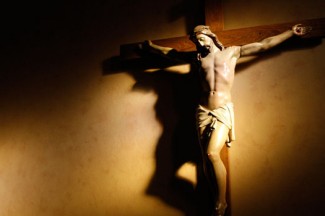
“My mother wouldn’t let me in a Catholic church when I was little,” she said, “because she thought it was so primitive.”
I said nothing; I could think of nothing to say to this little crowd of non- or ex-Catholics. But small knots of discomfort twisted in my chest and stomach. Although I had never really considered the question before, I knew instinctively that the crucifix was not to be dismissed as some relic of barbarity.
Pleasure leads to gratitude and God
It’s a cultural commonplace that the Church saddles its adherents with an inhibiting guilt for every time they feel good. Maybe the Gulf Coast brand of Catholicism I grew up with is different from the Catholicism practiced in other places, but I’ve never thought that I should feel guilty for having experienced pleasure. Quite the opposite, in fact. One of the things I like most about Catholicism is the affirmation it grants to pleasure and sensory experience, its recognition that the everyday joys we encounter via sight, smell, sound, touch, and taste can be not only morally permissible but also active spiritual goods: conduits to God.
Back in my early teens, long before I knew that St. Ignatius Loyola sought God “in all things,” I sought God in ordinary pleasure. God was in the aroma of black coffee, the fringed petals of the crepe myrtles I saw on the way to school, and Irma Thomas songs on the radio. God was there whenever the cafeteria served lasagna and whenever I had a couple of extra quarters in my pocket for a Coke or a Hubig’s pie: every pleasurable moment led me to gratitude, and gratitude led me to God.
So for me the idea of a religion that resists pleasure because it is pleasurable borders on the nonsensical. But a religion that ignores pain because it is painful is just as absurd. According to the book of Ecclesiastes, “There is an appointed time for everything, and a time for every affair under the heavens […] a time to weep, and a time to laugh; a time to mourn, and a time to dance” (Ecclesiastes 3:1, 4). Pain and pleasure are, like it or not, both essential parts of the human experience — and as such, they are both essential parts of the Christian understanding of God.
What does is mean for God to be human?
One effect of the Incarnation is that God became subject to the same vicissitudes of pain and pleasure as the rest of us. The Jesus who died in agony on a cross is the same Jesus whose first miracle was making more wine at a party. The Jesus who endured both physical and mental anguish during the Passion also endured the criticisms of those who thought he feasted too much and with the wrong crowd. I believe that to dismiss either aspect of Christ, his joys or his sorrows, is to miss Christ entirely.
There are those who say that they worship the Risen Savior, and that’s all that matters. To some extent, this is true. We should never forget that we are, in the words of St. Augustine, an Easter people. But Easter is meaningless without Golgotha. You can’t be resurrected unless you’ve died. Those who find the crucifixion too horrific to think about or to depict in art are ignoring the central Christian mystery: What does it mean for God to be human? The crucifix is one answer to that question.
Contemplating a crucifix doesn’t make you bloodthirsty. In fact, it can have the opposite effect. To look at a crucifix is to confront the depths of human perversity and human suffering, and that confrontation can make a person more cautious and compassionate. If we remind ourselves that we humans, in our haste and ignorance, killed God, then perhaps we’ll have less hubris and more mercy in our dealings with each other. By making ourselves aware that the God we worship has suffered, we can make ourselves more attuned to the sufferings of others (Matthew 25:40), and we may also find the strength to bear our own sufferings.
Additionally, a crucifix represents the awesome, abysmal depths of the love of God. If the crucifix strikes some as too indelicate, all I can say is that God loves us indelicately — savagely, ferociously. To the point of death. Even death on a cross. You don’t take love like that, stick it in a drawer, and forget about it.
I grew up so thoroughly enmeshed in Catholic culture that I never had to reason out my relationship to the crucifix. I felt rather than thought the ideas and sentiments I describe here, my prayer and practice shaped by inchoate intuition. The conversation in the seminar room that day forced me to articulate what until then I had taken for granted: that the crucifix is a window to an essential part of Christianity and of our human lives. Looking at a crucifix can deepen our love for God and our understanding of God’s love for us, and it can make us better able to endure our sufferings while sharpening our resolve to alleviate the sufferings of others. There’s nothing primitive about that.